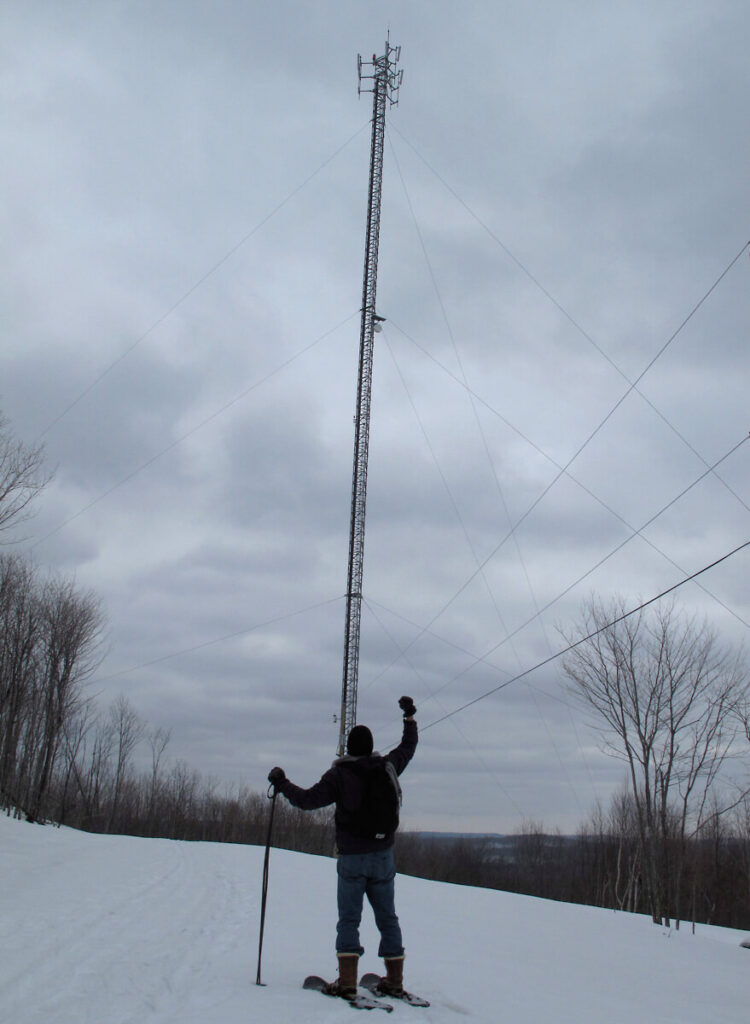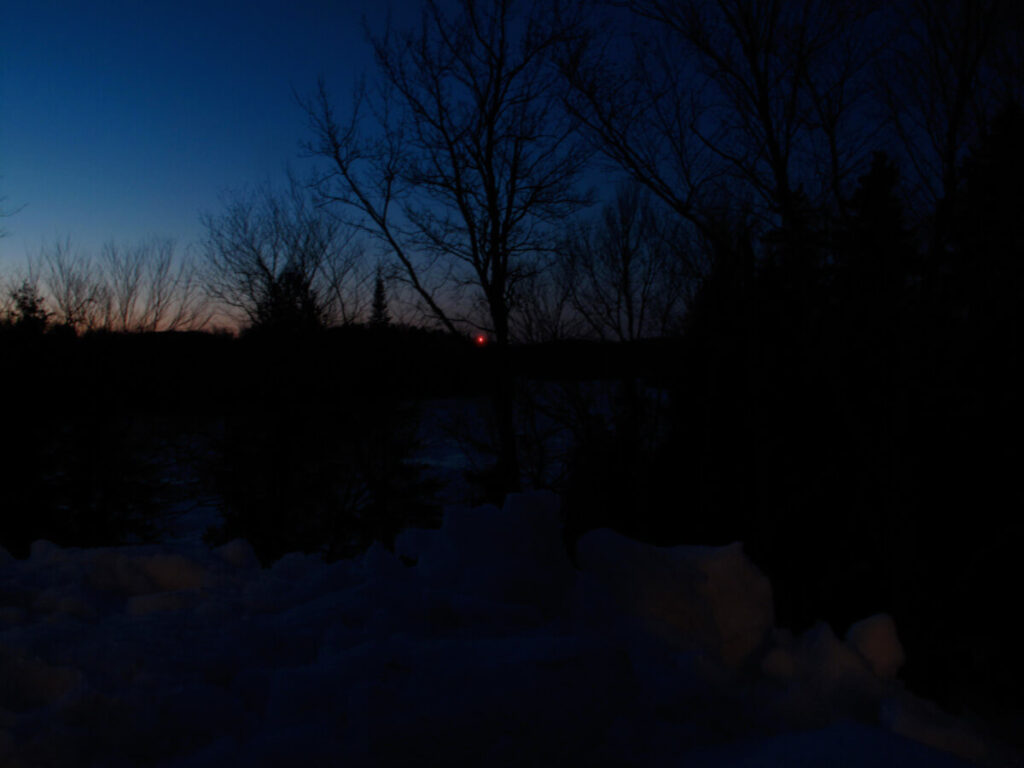
Out of nowhere, it appeared in the night sky last summer. Since time immemorial, nights in the Laurentian Mountains of Quebec had been utterly dark, speckled with stars, planets, and occasional meteor showers, while the moon in its shifting phases ruled over all. Then suddenly, literally overnight, there was a bright red beacon hanging above the wooded hills to the north, across the lake, all night, every night, unnatural, unblinking, and . . . unignorable.
With no other man-made light in view, save perhaps the yellow glow from the windows of a neighbor’s cottage across the lake—and even that usually only on weekends, when people came up from their homes in Montreal—the nights there are still very dark. But from that fateful night on, that piercing, alien red light ruled the darkness, like the Eye of Sauron in The Lord of the Rings. I guessed it was an aircraft beacon on some kind of tower, but its scarlet laser Eye was brighter than the stars, brighter than the planets, brighter even than the full moon, and worst of all, I could see it from every room in my house. Every night my eyes were drawn to that dot of red light above the northern horizon, glaring balefully, like a perpetual, malevolent warning. It was a symbol of everything I go to that place to get away from, and I was soon calling it the Eye of Satan.
The bedroom windows in my house were designed to reach down to the level of my bed, so I can sleep with my head beside the window, as near as possible to the outdoors. In summer I keep the windows raised high, screened from insects, but open to the night breezes and the sounds of the wild, like the stirring call of the loons echoing across the lake. In winter, I leave the curtains open (at least when I’m alone, free from spousal objections), so I can look up at the stars, or falling snow, and awaken at first light to see the new day. However, now if I even briefly open my eyes during the night and look outside, I look straight into the Eye of Satan.
Scanning through binoculars at twilight, just as the Eye became visible, the tower itself was noticeable among the tree branches for its straightness—as my drum teacher, Freddie Gruber, pointed out years ago, “There are no straight lines in nature.” When the daylight faded into darkness, the Eye glowed brighter.
As a symbol, it is rather too obvious, and a red light bulb in the sky is not the world’s biggest problem, I know. Given that most people in the western world dwell in a sea of artificial light anyway, they might not even comprehend the problem. But it’s different for those of us who choose to live in the woods, and that man-made intrusion was a serious blight on my personal soulscape. I can’t help but wonder why it is possible for some corporation, and some cooperating government agency, to commit such an invasion of a person’s night sky—of so many people’s night sky. In those low, glacier-raked mountains of forests and lakes, that beacon was surely visible for hundreds of square miles—which would be its purpose, of course, but considered as a first-class felony of “light pollution,” it was pretty heinous.
Shouldn’t they have had to ask us?
Warn us?
Shouldn’t we have been able to say, “No thank you!?”
Well, obviously not, because there it is, and there it will remain, through every night I spend in that house, smack in the middle of my horizon.
The Eye of Satan was soon identified as a beacon on a telecommunications tower, because it brought another unasked-for change to our local atmosphere: cellular telephone service. For sixteen years I had been contentedly living in an area without cell coverage—kind of liked it, really—but one afternoon last summer I was standing in the kitchen with my property manager, Keith, and his cell phone rang. We looked at each other, then at the phone, and sure enough—suddenly we had cell service. Thank you, Satan.
All through my time in Quebec last summer, that bright red night-light haunted me, stabbing my eyes every time I looked out toward the dark lake, and it was the same again this winter. Acts of sabotage were contemplated, of course, involving plastic explosives, a high-powered sniper rifle, or, as one neighbor suggested with a smile, “Just go over there and unscrew the light bulb!” I knew well enough there was nothing to be done about it—“What cannot be altered, must be endured”—but it loomed large in my night-thoughts, and I decided I had to go there, hike to that tower. Just to see where it was—and maybe stand beneath it and shake my fist at the Eye of Satan.
This February I recruited a willing accomplice in my neighbor, Charles (silent “s,” à la française), a good-humored, nature-loving French-Canadian. I have liked Charles since we first met many years ago at local association meetings, which could sometimes generate controversy, demonstrating the contrasts in my neighbors’ reasons for building a house on a lake in the woods—basically the difference between pioneers and suburbanites. Charles would often be the voice of cool, wry reason, and made some good jokes. His wife, Marthe, was quiet, pretty, and, I learned later, an excellent painter.
But what really won my lifelong affection for Charles was an act of compassionate, impetuous generosity, so typical of that quality of open warmth, chaleur, I have always admired in French-Canadians. One afternoon in the summer of 1998, when I was hiding out in the woods after the loss of my family, I was on the lake in my rowboat—as always back then, vainly trying to escape, somehow, somewhere, by any kind of motion.
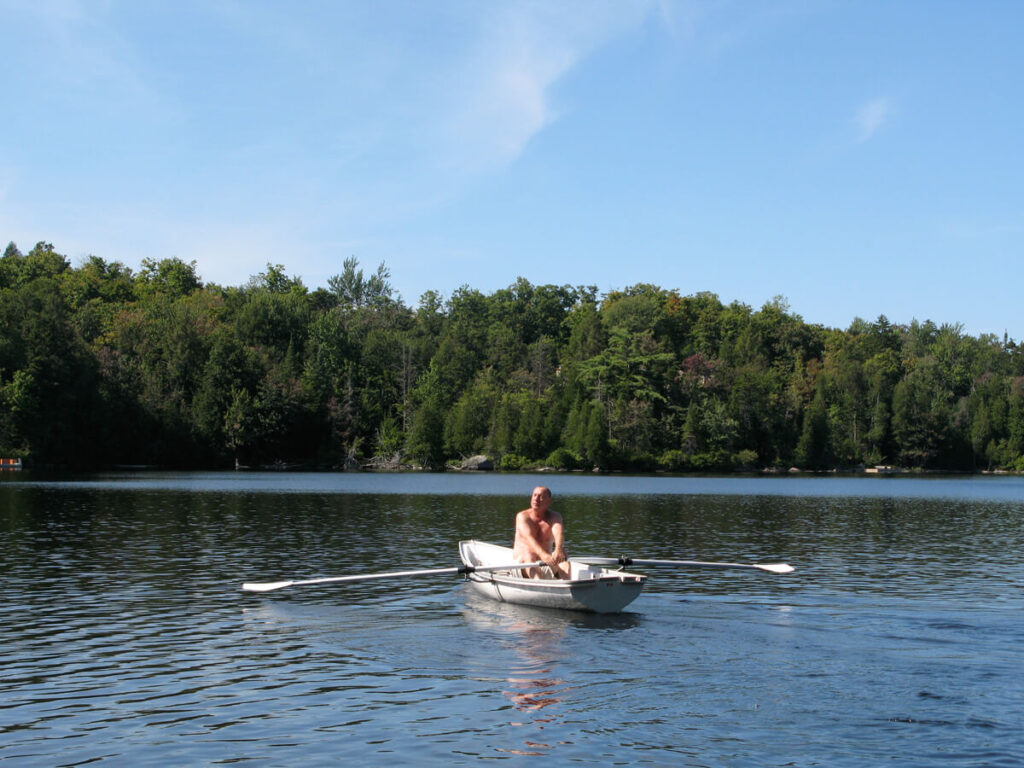
photo by Carrie Nuttall
That day I was having trouble with one of my oarlocks, and when it came undone far from my dock, I sat floating on the still water with one long oar across my legs while I tried to repair it. Across the bay I recognized Charles and Marthe in their canoe, and I saw them start to steer in my direction.
To describe my state-of-mind that summer, without getting “all into it” too much, I was awfully fragile. That day in particular, I was already disproportionately upset over the momentary crisis of a broken oarlock, and in general, I was pretty shy of contact with people I didn’t know well. So, to be frank, I really didn’t want to talk to anybody.
When their boat drew near, Charles, in his perfect English, and perfect French-Canadian accent, made me a speech I will never forget.
“Every night I see your light across the lake,” he said, then lowered his eyes and shook his head. “And . . . I think about you.”
He went on, and though I was getting teary (other people’s emotion could so easily trigger my own), what Charles said was so right, so beautiful. The gist of it was, “If there’s ever anything I can do for you, or just be there for you, you have only to call, or knock on my door, anytime.”
Moved, I nodded and said, “Thank you, I appreciate that.” And I meant it.
As I wrote in Ghost Rider, it was impossible for anyone to really relate to me at that time, and I was aware that facing me could be difficult, even for my friends and loved ones. My reading of what some good people offered me was a simple statement: “I don’t know what to say—but here’s my heart.”
That was a message I could receive, even then, and that’s what Charles was saying. The feeling was repeated in Marthe’s dark eyes, brimming with deep sympathy.
So when I moved across the lake a couple of years ago, next door to Charles and Marthe, I was glad to get to know them better. One day last winter Charles invited me to go snowshoeing with him, and he guided me through the woods to a trail he knew that led to an uninhabited lake where great blue herons nested. Their huge nests of woven sticks, abandoned in winter, formed a colony, in a line of dead trees along the shore.
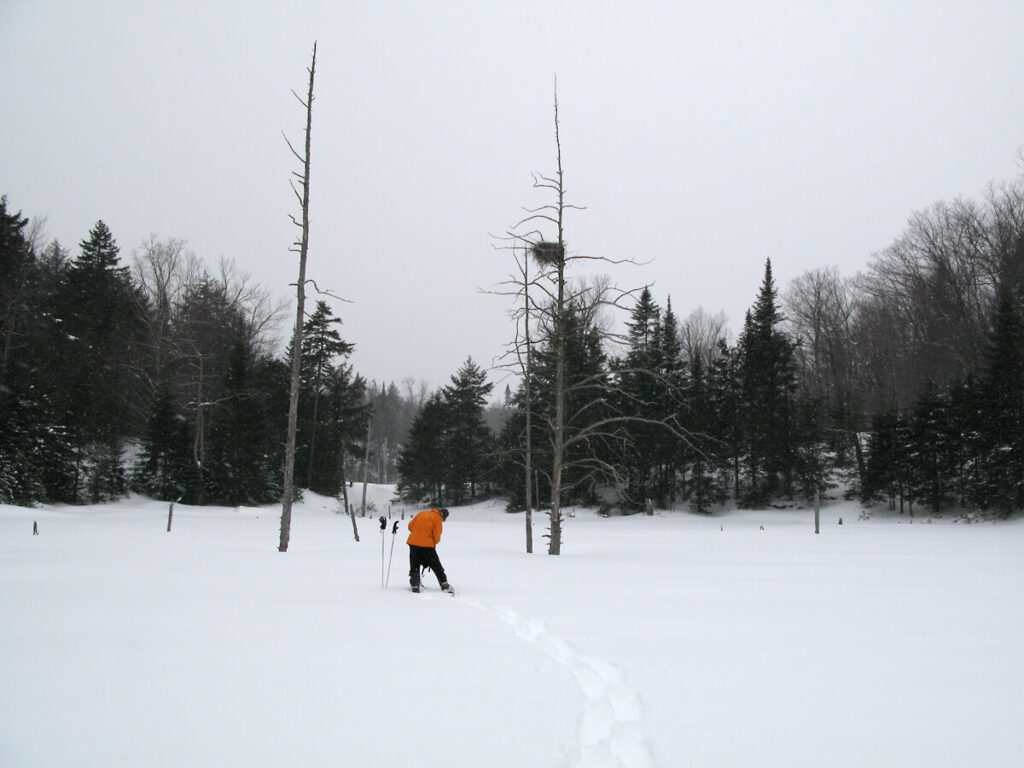
Like many of my neighbors, Charles lives and works in Montreal most of the week, and spends his weekends in the Laurentians, just an hour or so north. This winter he and I have been snowshoeing together every Saturday, exploring the wooded backlands around us, and introducing each other to hidden trails we have discovered on our solitary ramblings.
Charles’s knowledge of nature, and his love for nature, gave us an immediate bond, and we are both entirely happy to be tramping through the winter woods for hours. While we hike, Charles and I trade the names of trees and animals in English and French—the hemlock is la pruche; the fir is le sapin; the hare is le lièvre (Charles is amused by the English word, and when we cross their tracks, he always has to spell it out, “That’s a hare, h-a-r-e”); the ruffed grouse is la gélinotte huppée; the moose is l’orignal.
As with all of my French-Canadian friends, I always regret that our conversations have to be in English, but my French is just not up to that challenge. My reading en français is workable (at least to the level of Tintin books, like a ten-year-old), and sometimes I can say what I want, but I won’t understand the rapid-fire response, especially in a Québécois accent. As I tell them, “J’ai le vocabulaire, mais je n’ai pas l’habitude.” I just haven’t spent enough time among francophones to develop the facility, and the “ear.”
Charles could see the Eye of Satan, L’Oeil du Diable, from his house, too, and was likewise curious about it, so as a “conceit” for one weekend snowshoe hike this winter, I suggested we go in search of that tower. We took a compass bearing from our houses, and set off across the frozen lake, buried in deep snow. We guessed it might be a couple of miles.
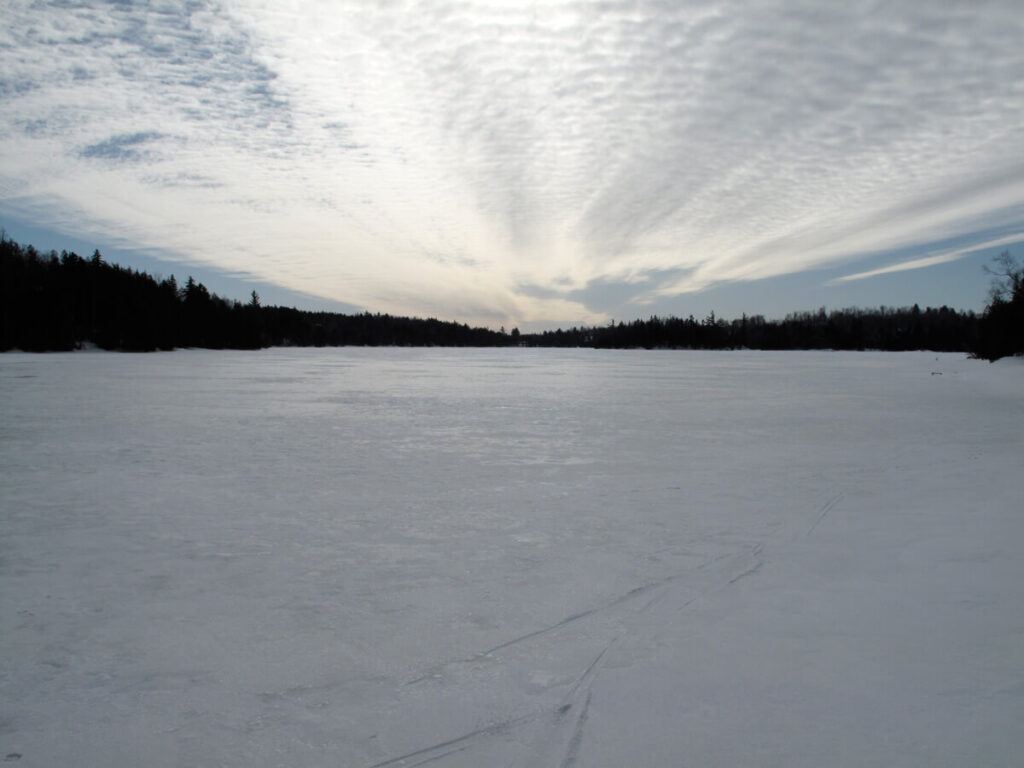
The surface of the snow was hard that day, because earlier in the week there had been a brief thaw with some rain. The temperature had dropped again, and the deep snow refroze with an icy crust, so traveling was relatively easy. On the open lake, swept by frigid winds that further toughened its skin of snow and ice, you could even get by without snowshoes, and though the snow was softer in the woods, it was still easier going than breaking trail through deep powder.
On my solo wanderings in the winter woods, I have been musing over a theory of the Geology of Snow—how over the course of a winter the snow resembles a high-speed demonstration of the shaping of a landscape, by wind, water, temperature, and pressure. Mountains rise and fall; mesas, cliffs, and dunes are shaped; blocks and faults crack and shift beneath the surface; watercourses are carved; and always there is change.
One good example can be seen where an animal has crossed the snow, pressing down a line of tracks. The air temperature rises a few degrees above freezing, a little rain falls, and the surface recedes—now the pressed-down tracks are left higher, embossed on the surface like a row of tiny mesas. Because the circles of compacted snow had been made harder, like the capstone of a mesa, they resisted the erosion that cut away around them. In just this way the pillared rock towers of the American West, like Monument Valley, were formed—though that took a few million years, rather than a day or two (a winter’s creation-myth, perhaps, as well as high-speed science).

Across that day’s Geology of Snow, Charles and I headed into the woods north of the lake, where there were no trails. But with five feet of frozen whiteness smoothing over the underbrush, roots, rocks, and marshes, and the trees bare of leaves, one of the great advantages of snowshoes is that we could pretty much walk anywhere we wanted.
Taking turns breaking trail, or walking beside each other, we left a winding pair of tracks that meandered around low-hanging branches, or between dense thickets of scrub, but we tried to keep to our bearing, just west of north. The trees were relatively small in those third-growth woods, because—as in pretty well all of Eastern Canada and the United States—the Laurentian forests have been clear-cut twice over; once in the late 1800s and early 1900s, and again in the 1950s. The great oak and white pine forests that once shaded that land with a canopy as high as 200 feet would never grow back, crowded out by faster-growing poplar, birch, spruce, beech, and fir. Charles and I always pointed out the rarities, like good-sized hemlocks (les pruches), wondering how they came to be spared by the loggers (sometimes, I have learned, to make shade for their camps). Generally, the bigger trees these days were bushy cedars in damp lowlands, short-lived poplars and birches, and vanishingly few remnant pines.
Originally, most of the huge white pines went to build British warships, thus constructing the world’s most powerful navy in the eighteenth and nineteenth centuries. In the time of the Napoleonic wars, the ports around the Baltic Sea—and thus alternative sources of pine—were blockaded, and the largest white pines in Canada, three feet or more in diameter, were reserved for the British navy.
After the loggers came the settlers. The earliest Europeans to homestead in the Laurentians were French Catholics and Scots-Irish Protestants. The modern-day villages mostly had names commemorating Catholic saints, but the old-time township names told a different tale—Kilkenny, Kildare, Derry, Suffolk, Harrington, and Wentworth. Many of those were “Frenchified” in the 1960s and ’70s, but some remain.
The early settlers faced an insurmountable challenge, for after clearing the forests and rocks with axes and stoneboats, they soon learned that the glacier-scraped soil was thin, rocky, and impoverished, while the growing season was dangerously short. Still, despite that reality, in the later 1800s a Catholic priest, the famous (should be infamous) Curé Labelle (le Roi du Nord, King of the North), a huge man for his day, over six feet tall and 300 pounds, had a vision. When he was posted to the remote Pays d’en Haut (high country) north of Montreal, he was determined to bring in more Catholic settlers. Many had been fleeing south to work in the mills of New England, not surprisingly, and he wanted to increase their numbers against the Protestants—and not incidentally, increase his own power and influence. Curé Labelle promoted the agricultural potential in the Laurentians, and like the American hucksters who lured settlers to the arid West by assuring them, “Rain follows the plow,” his misguided efforts were successful, temporarily.
The persuasive curé even convinced the Montreal authorities to bring in a railroad, Le Petit Train du Nord, by 1876, but the new arrivals it brought had no more success at farming. Many families suffered terribly, through harsh winters, fierce mosquitoes, unproductive land, and desperate need. Eventually some of them just gave up, leaving behind abandoned farms and full graveyards. Others survived by hiring out as lumberjacks in winter, and by burning vast amounts of hardwood to make potash—rendering the ashes of maple and beech into a distillate used in the making of glass, soap, fertilizer, and fabrics. Apart from a little maple syrup, potash was their only cash crop, but it took a lot of work, and a lot of trees—in a one-time-only, slash-and-burn harvest.
As demand for construction lumber rose in the United States, water-driven sawmills were built on every river and stream of any force, and villages grew around them. The sawmills were insatiably hungry for trees, too.
The final blow to the Eastern Canadian forests was a blight, introduced from Europe, that attacked white pines, killing them from the top down. Because Canadian white pines would not grow in Europe, the British raised crops of seedlings there, then shipped them back to Canada for transplanting. Result: disaster.
When all of the big trees were gone, the remaining scrub was harvested for pulp, to feed the twentieth century’s demand for paper. In that connection, a Winston Churchill quote comes to mind, one I cited in Roadshow. In 1929, the future British leader and wartime hero visited Western Canada, and remarked, “Fancy cutting down all those beautiful trees to make pulp for those bloody newspapers, and calling it civilization.”
Photographs of the Laurentians taken in the early twentieth century show bald hills and empty fields—though sometimes dotted with summer vacationers, or winter skiers. These people would be the “cash crop” in later years, filling Curé Labelle’s Le Petit Train du Nord, and the many hotels and boarding houses that sprang up to lodge them.
(My appreciation to Joseph Graham’s fine book, Naming the Laurentians, for some of this historical background.)
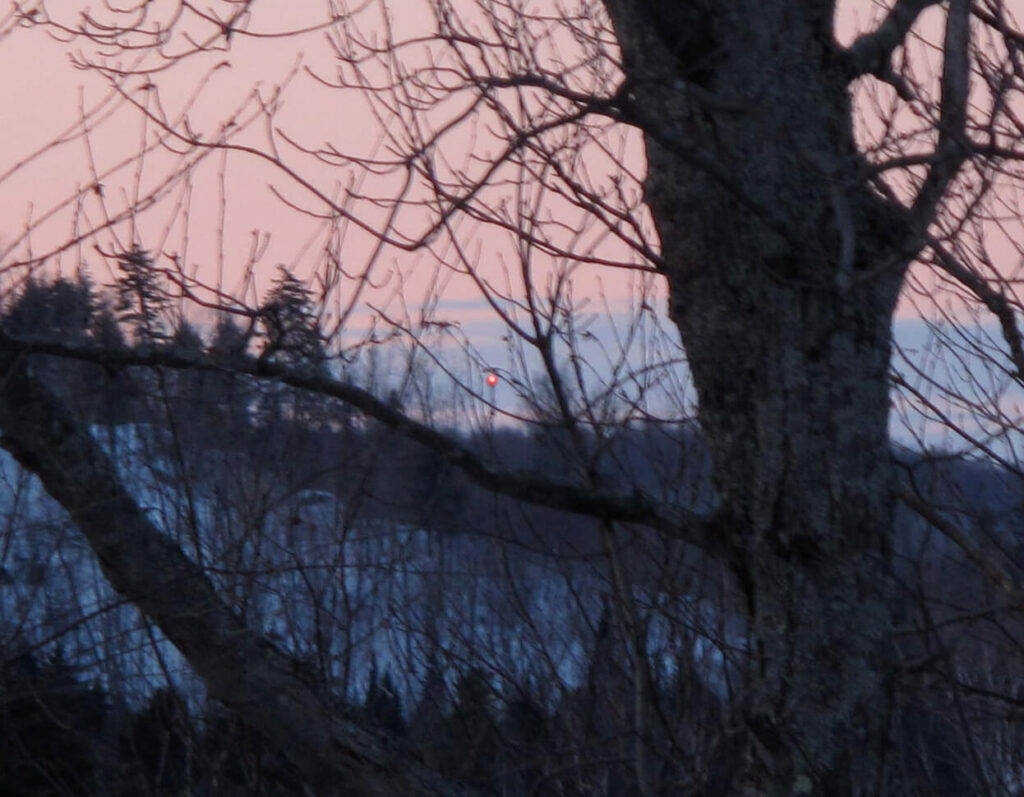
When I was a boy, growing up in Southern Ontario, our family sometimes traveled “Up North,” to a campground or rented cottage. When I walked into the shadows of the rich-smelling northern woods, through pine needles, ferns, and arbors of sumac, I always imagined I was entering the primeval forest—thrilled to think that where I stepped, perhaps no human had ever set foot before. Eventually coming to understand the reality of the wholesale logging that had stripped that land again and again, and that only a scrubby imitation of its former majesty had regrown, was one of those poignant surrenders of illusion for reality, of innocence for knowledge. That exchange is sometimes difficult, even painful. As I wrote in a song long ago, “Illusions are painfully shattered/ Right where discovery starts.” Ain’t it the truth.
For myself, I would always rather know than not, would rather pay that price for the apple of knowledge—because painful truth seems preferable to blissful ignorance.
But I would sure give a lot to see the forests of Quebec as they once were.
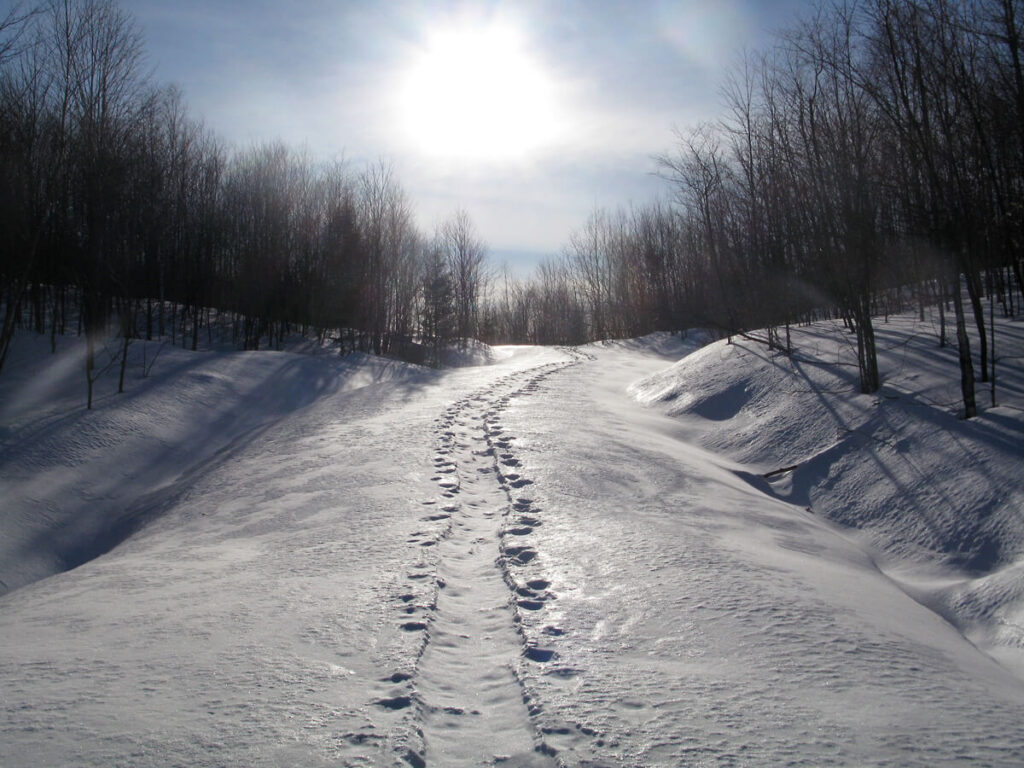
Charles and I followed the rolling contours of those ancient, glaciated hills, working up and down through the scrubby young trees for a couple of miles, all the way over to the giant hydro-electric lines.
There we stood beneath another satanic construction, an electro-mechanical network of immense scale that beggared belief. Gigantic, robotic-looking metal towers, with thick cables sagging between their upright trusses, marched along a treeless gash (kept clear by herbicides), a naked “corridor” that was 140 meters, 450 feet, wide (one-and-a-half football fields). That monstrous procession stretched all the way from James Bay, hundreds of miles north, down to the population centers of southern Quebec and into the Northeast United States. The source, the dams and turbines of Hydro-Québec on the LaGrande River, were 1,000 kilometers by air north of Montreal, and with the occasional zigzag angles the corridor took to avoid lakes and higher mountains (“no straight lines in nature”), the entire electrical superhighway was probably nearer 1,000 miles long.
The silhouettes of those immense towers, and even the heavy wires shining silver in the sun, could be seen from many parts of our lake (such as my kitchen window, alas). Like the Eye of Satan, they made another unfortunate intrusion into our scenery and sense of wilderness, but there must surely be yet a bigger story behind that massive scar across the Earth. If I were an investigative reporter, rather than merely a cranky observer, I would want to find out what that project really cost, in billions of dollars and in immeasurable, permanent environmental devastation—especially the dams and infrastructure in the Far North, for example, where no one can see the mess they made.
That massive Hydro-Québec project was conceived in the 1970s, before such barriers as environmental regulations and reviews were in place. Construction began without even informing the people who would be affected most—the Cree and Inuit natives who lived and hunted in the region. The project swallowed an area larger than New York State, and like the long-lost Laurentian forests, which no one alive or unborn will ever see, the North is a deceptively fragile landscape. It does not grow back.
And when (not if) those mighty towers are struck down by an ice storm, as happened in the winter of 1998, vast numbers of people will be left without electricity through many frigid days and nights—as long as two weeks, that time. And what unimaginable millions must it have cost to fix that disaster?
Of course, hydro-electric power seems preferable to, say, burning coal, as the United States relies upon for more than half of its electricity (for complicated political reasons that we needn’t get into right now, thank you), but still—hydro projects make a heck of a mess, too. In recent years, even in countries like China and Brazil, such enormous enterprises of damming and flooding are resisted—if not actually prevented.
At home, nowadays the simple “eyesore” argument is gaining traction, and even seemingly benign wind farms are banished by people who treasure their natural landscape, like the residents of Cape Cod. In otherwise aesthetically sensitive Quebec, alas, that was not a consideration in the bad old 1970s.
This photograph, taken from a high hill to the south, encapsulates the dynamics of the modern Laurentians: young trees in the foreground are growing back after a recent clearcut; the lakeside cottages in the middle ground form an imagined Eden; on the horizon, the Tower of Satan to the left, and to the right, the bare white patch under the power lines, and the silhouettes of their towers.
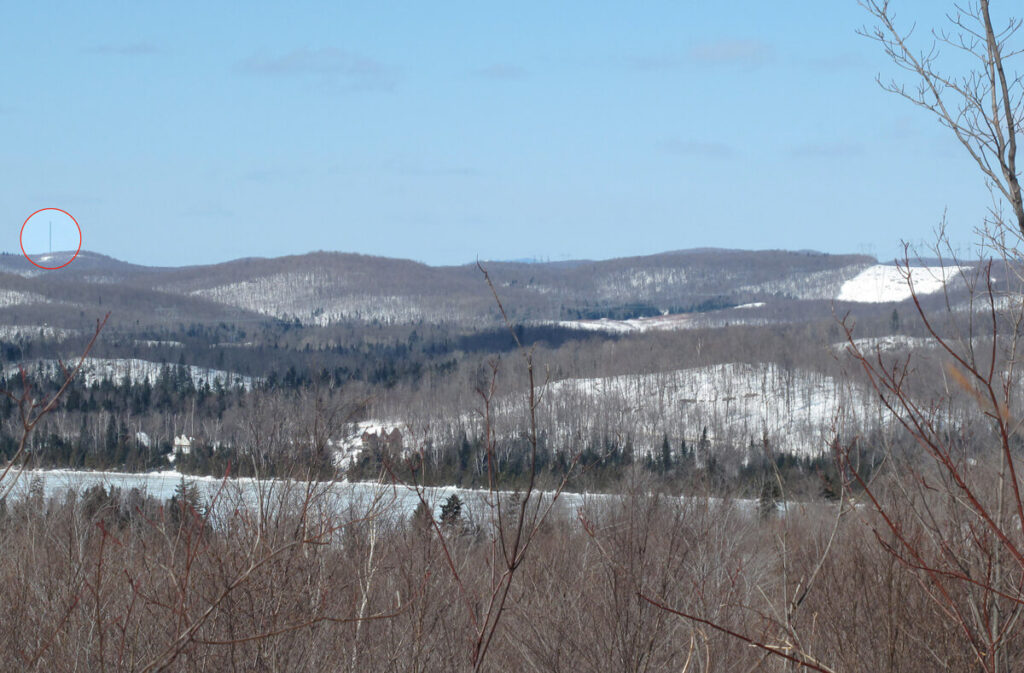
In principle, those Hydro-Québec power lines are like the aqueducts in the American West, which also slice for hundreds of miles across uninhabited wilderness, deserts and even mountains. But water is, by nature, prettier than metal towers. In the same way that a significant amount of water in those aqueducts is lost to evaporation, so the hydro lines suffer leakage, too. The old-time fear that the electro-magnetic energy they radiate caused brain tumors in people who lived under them has been discredited, but still, I once stood beneath those Hydro-Québec power lines during an icy rain, and heard the wires crackling and buzzing, like static electricity.
Charles and I emerged from the woods into the cleared area under the towers, the snow solid white across the bare, heaving landscape—a shroud laid across a skeleton. We climbed a steep, high ridge, hoping to get a view of Satan’s Tower, but saw nothing but bare trees all around. We paused in the open sunshine to drink some water and share the goodies in our packs (including some delicious nuts roasted in curry powder, sent by Marthe, an artist in the kitchen as well as on canvas).
The hydro-line corridor had long been a popular snowmobile and ATV route, which seemed a suitable match, and as a motorcyclist myself, I could hardly resent these recreational “cousins”—as long as they weren’t ruining my cross-country ski trails. As Charles and I stood in the sun, contemplating our next move, we heard the buzz of engines in the distance, quickly drawing nearer, and louder. Three snowmobiles crested the ridge and headed north in a steady, metallic snarl, and after they passed, their exhaust smell hung in the thin winter air for a long time.
We struck off into the woods in the direction we thought the tower should be, but even the crowns of the hills were thickly wooded, and obstructed our view of anything higher. We tried to keep tending upward, and northward, with frequent checks of our compasses (boussoles). At the summit of every hill (colline), we would hope to see the object of our quest, La Maudite Tour du Diable, but there was no sign of the phantom tower. We headed down into a long, narrow valley and across a small lake, level white and open to the sun again. We paused on the far shore beside an abandoned hunting cabin, its roof collapsed beneath the snow. A snowmobile trail led up through the trees to the north, and we agreed to follow it for a while, and try to make it up one last hill, then call it a day.
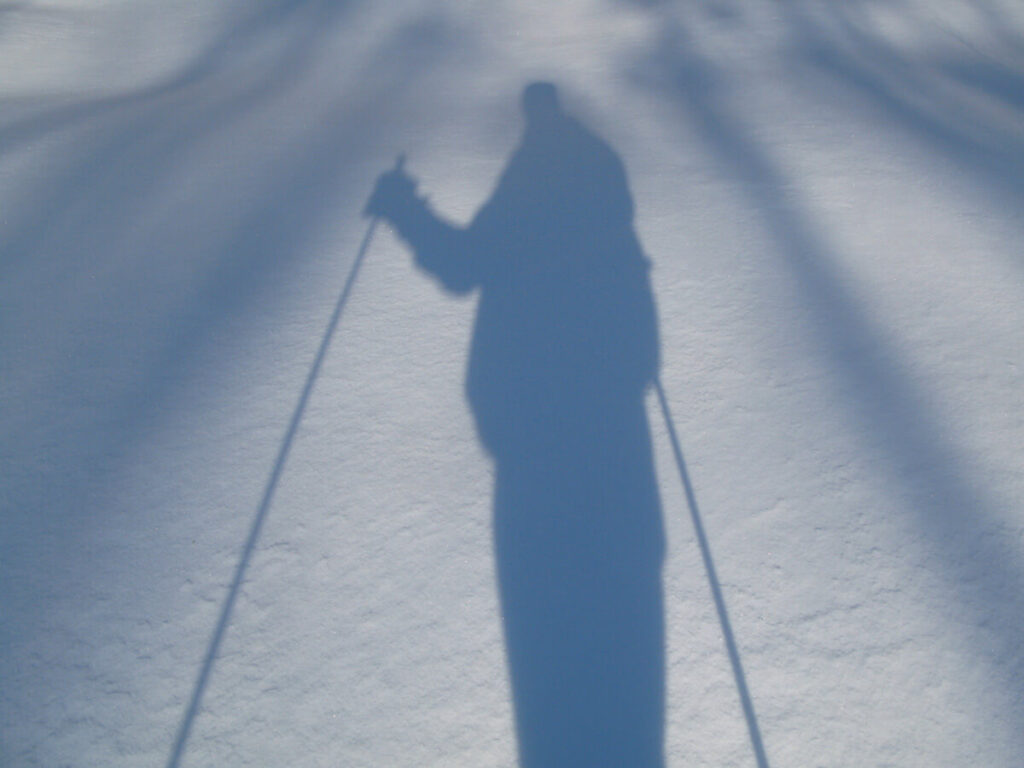
We had been laboring up and down over the deep snow for more than two hours, and it was time to be heading back, while we still had enough daylight, and at least an hour to spare (call it “trailcraft”). It was early afternoon, and winter days are short. Giving up on a mission is always difficult, but when you are far from home in the winter woods, you have to be—well, as Charles said to me, “I am glad you are . . . sensible.”
And thus did the First Expedition end in failure. But as I said to Charles, “For me, the exploring is worthwhile for its own sake. Like the saying I once heard about fishing: ‘Only a fool thinks he goes fishing to catch fish.’”
In Ghost Rider, I described the kind of exploring Charles and I were doing as “disorienteering,” and in guessing the distance to that tower to be only a couple of miles, it would turn out that we had “misunderestimated” that distance by a factor of about three. The Eye of Satan was much farther away than we thought . . .
Looping back toward the power lines, we were excited to come across the unmistakably huge tracks of a pair of moose, most likely a female and her yearling calf, as the males are solitary (and ornery). We followed the deep troughs where the two had struggled through snow up to their great bodies, and saw the hollows where they had rested overnight, and their truffle-sized droppings. Moose are rare and elusive in our area, and hunters take a few of them every fall, so we were always glad to see what Charles called “signs of moose activity.”
Back home that night, I pored over maps, and studied the aerial photographs on Google Earth. The tower had only existed for seven months, so wouldn’t appear on maps, or even on satellite images that might be years old (some of them lo-res, too, in that backwoods area), but I was searching for some clue of where to look next—an access road, perhaps, that a tower would require for construction and maintenance.
Then I had an inspiration: Who would have to know about an aircraft beacon?
A pilot, of course!
I sent an e-mail to my old friend Brian Laski, “Vings,” who flew for Air Canada, and asked if he could help. He made some calls to aviation and associated government agencies, ordered a relevant chart, and came up with a few suggestions.
Most of them were too far away, or in the wrong direction, but one set of coordinates looked promising—a little farther away than Charles and I had thought it must be, but on the right compass bearing. On Google Earth I picked out a small, square structure on the site—possibly the tower’s utility building?
The next Saturday, Charles and I launched what history would come to know as the Second Expedition. We drove to a trailhead farther north, and snowshoed into the woods along the old railway alignment. Abandoned in the ’60s, the tracks had long ago been taken up, the roadbed now devoted to cross-country skiing, snowmobiling, snowshoeing, and, in summer, bicycling and hiking. (“Rails to trails,” one of the better devolutions of modern times.)
I was familiar with that part of the so-called Aerobic Corridor from a couple of mountain-bike rides out that way years ago, and on Google Earth, I had spied a small logging road that would take us to where the tower was supposed to be. The clues all added up.
Once again, the snowshoeing was easy that day, especially where a snowmobile had packed down the trail, but the structure I had seen from space turned out to be an abandoned cabin, perched lopsidedly on an old flatbed trailer.
I was disappointed—and puzzled. Those coordinates were supposed to be official aviation data, and I had to wonder, wouldn’t pilots need to have, you know, accurate information? Mysteries abounded on this quest.
Charles and I continued west along that logging road, unplowed and untracked, scanning the treetops all around for a glimpse of that cursèd tower. The road ended at a good-sized lake, with only one tiny cabin on its far shore. We headed out to the middle, hoping for a more open view, and voilà—there it was, rising above the trees to the north: the Tower of Satan. However, Charles figured it was still a few kilometers away, and his photo, taken on full, 5X zoom, seemed to bear out his guess.
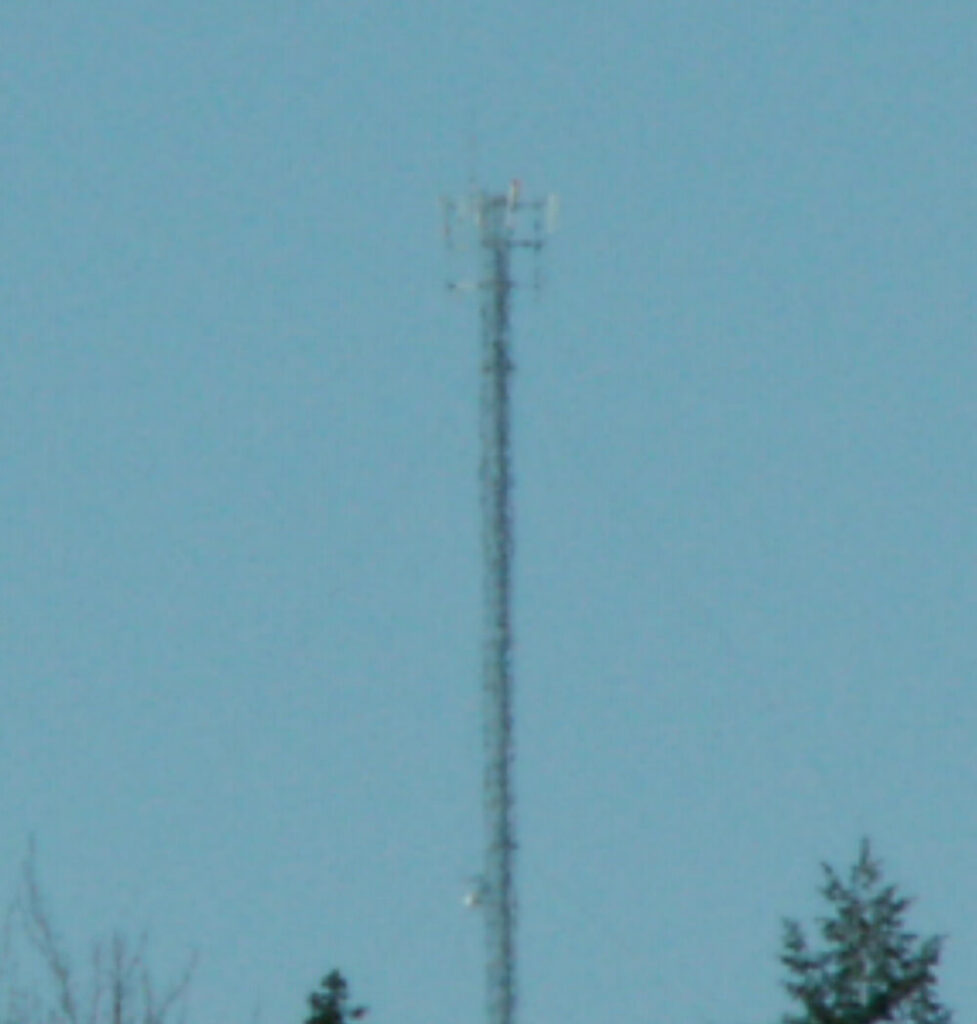
We took a bearing on our boussoles, and tramped off into the scrubby bush. We could tell that area had been clearcut only ten or fifteen years before, as all the trees were skinny saplings, and their density made for heavy going. We meandered along for another hour, trying to keep to our compass bearing, and to the high ground, where we might catch another glimpse of La Maudite Tour du Diable. But once again we were forced to turn back—by the lateness of the hour, and by good sense. The Second Expedition, alas, would also end in failure.
My determination was only reinforced, though, and the next day I had another inspiration. Charles had mentioned that elevations were shown on Google Earth, and once I figured out where that information was displayed, I scrolled over the “area of interest,” looking for the highest peaks. If dead-reckoning navigation and high-tech information had failed, perhaps old-fashioned deduction would succeed. I thought of the Sherlock Holmes maxim: “Once you eliminate the impossible, whatever remains, no matter how improbable, must be the truth.”
I identified a few higher peaks, and marked them by their elevations in meters: Peak 500, Peak 526, and so on. One of them was near a two-lane highway north of us, and although it seemed too far away, I took a drive along there to have a look, and bang—there it was.
Fittingly, I glimpsed it this time through the thick cables of the James Bay powerlines, just where they crossed that road. The steely-gray tower rose starkly above the winter woods, straighter than nature, and a few hundred feet taller. Its satanic eye was not visible in daylight, but through my binoculars I scanned the heavy trusswork barbed with angular antennas and a drum-shaped reflector, and saw that the tower’s great height was anchored with huge guywires. It was indeed a monster.
Measured on the satellite map back home, I was amazed to learn that it was almost nine kilometers, more than five miles, from my house—that diabolical light was so bright, and the tower itself, in twilight, was as visible through binoculars from my balcony as it is in this photo. Not as close, of course, but in proportion, just as big.
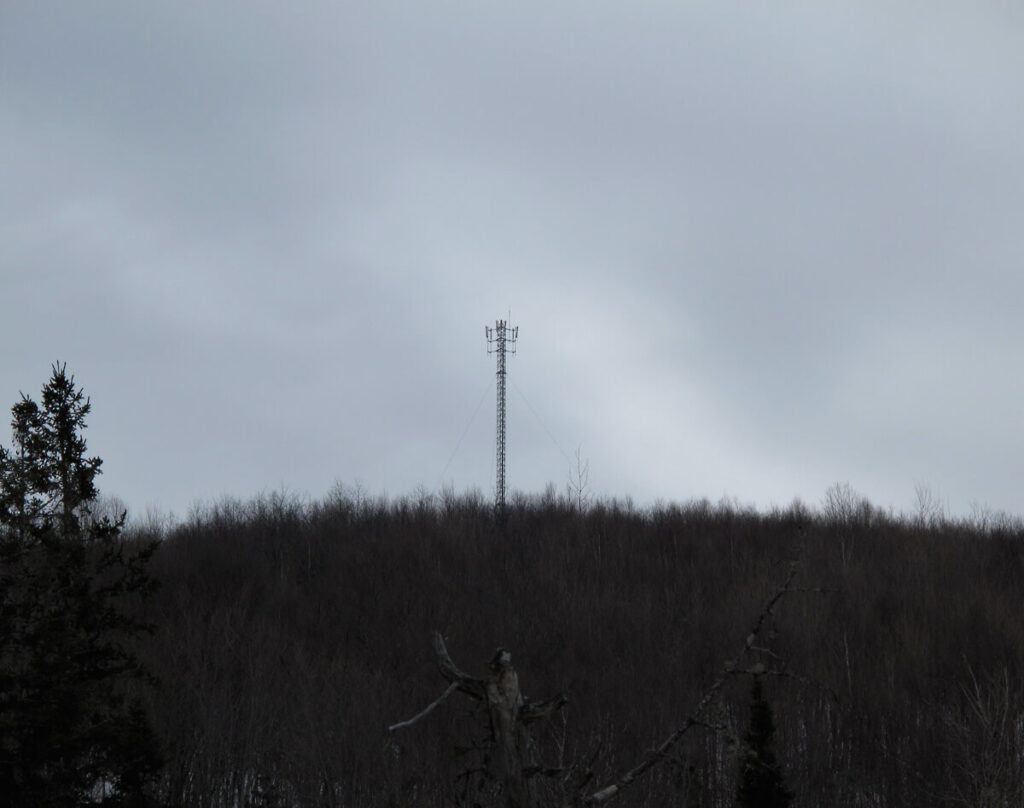
Well, obviously, there was still one step remaining on this quest, one more peak to climb. Like Frodo and Sam in the mountains of Mordor, Charles and I would have to travel to the very Tower of Sauron. We had no Ring of Power, nor even a lump of gelignite or a high-powered rifle, but . . . I could shake my fist at it, maybe throw a few snowballs.
The following Saturday, Charles and I drove to the area and parked at the foot of a small, unplowed road. We strapped on our snowshoes, and headed up the steep grade. On one side, wooden utility poles, obviously fairly new, carried electrical wires upward, and in the middle, a single snowmobile had passed up and down just before the previous day’s light snowfall.
The day was gray and mild, a couple of degrees above freezing, and we were soon feeling warm—and winded. We paused for a breather, and Charles smiled and tapped his chest, “My heart needs to readjust its rhythm!”
Climbing onward, looping around the peak among the dense young trees, bare and spindly, eventually the tower’s trusswork and antennas came into view. We knew we were getting close.
And finally we stood before that tower, amazed at the sheer immensity of its construction—Charles counted the meter-high triangular trusses all the way to the top, and guessed it was close to 300 feet. Even the three bases anchoring the thick guywires were protected by chain-link fences (we wondered from what?), which were presently almost completely buried in snow, and a larger enclosure surrounded a metal building and the tower itself. We could see that the snowmobile had stopped there, and the gate had been opened by a maintenance inspector, who had then circled back down. Reading the snow, Charles and I figured that visit had only been two days before.
The domed red light at the top, the veritable Eye of Satan, glowed with an inner fire—apparently lighted in daylight hours as well—and even up close, it really did look evil. We lined up our boussoles toward home, guessing where our lake lay, far to the south among the rounded, receding hills. Scanning around the horizon with our binoculars, we saw northward all the way to the ski slopes of Mont Tremblant—thirty-three kilometers, twenty miles, away. We took a few commemorative photographs (as if at the summit of Everest), and headed down again.
The Third Expedition had finally achieved the goal of our quest.
However, as has been observed by many another quester, a holy grail, or a satanic light, may launch a quest, but is not really the object. The quest is the object, and the journey itself is the real reward—“Only a fool thinks he goes fishing to catch fish.”
For me to finally stand at the foot of that tower and shake my fist at it didn’t change a single thing, of course, but taking part in those Three Expeditions, tracking the Eye of Satan to its lair, had been fun for Charles and me, and taught and showed us many things. The natural world, and the electro-mechanical world, had yielded a few mysteries.
My night sky will continue to be ruled by that bright red Eye on the northern horizon, no doubt for the rest of my days, but I feel better about it now.
I know where it lives.
